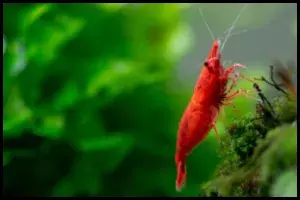

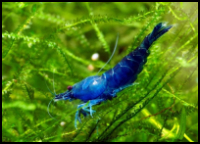
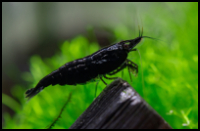
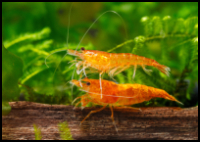
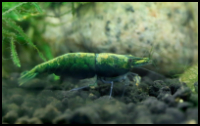
Quick Care Details (Table)
| Livestock Characteristics | Value |
|---|---|
| Care Level | Easy |
| Temperament | Peaceful |
| Diet | Omnivore |
| Maximum Size | 1.5 Inches |
| Minimum Tank Size | 10 Gallons |
| Plant Safe | Yes |
| Temperature Range | 68-78F |
| PH Range | 6.5-7.5 pH |
| KH Range | 2-8 dKH |
| GH Range | 6-10 dGH |
Species Specific Categories
Helpful Video
Care Details
Aquascape
- Provide a well-planted aquarium with live plants, mosses, and hiding spots like caves or driftwood.
- Incorporate smooth surfaces and nooks for molting, as shrimp shed their exoskeleton during growth.
- Use natural decor elements to create a comfortable and aesthetically pleasing environment.
Substrate
- Choose a soft substrate such as sand or fine gravel to allow for easy digging and foraging behavior.
- Avoid rough or sharp substrates to prevent injury to the shrimp.
Disease Prevention
- Quarantine new shrimp before adding them to the main tank to prevent introducing diseases.
- Maintain excellent water quality through regular water changes and proper tank maintenance.
- Avoid overcrowding, as it can lead to stress and weakened immune systems.
Filtration
- Use a gentle and efficient filtration system to avoid strong currents that may harm the shrimp.
- Consider using a sponge filter or pre-filter to prevent shrimplets from being sucked into the filter.
Lighting
- Provide moderate to low lighting, as excessive light may encourage algae growth and stress the shrimp.
- Use adjustable lighting options to create day-night cycles and simulate natural lighting conditions.
Water Flow
- Neocaridina shrimp prefer gentle water flow, as strong currents can be stressful and exhausting for them.
- Position filters and powerheads to create smooth and slow water movement.
Hardiness
- Neocaridina shrimp are generally hardy and adaptable to a wide range of water conditions.
- They can tolerate a pH range of 6.5 to 7.5 and a temperature range of 68°F to 78°F (20°C to 26°C).
- Maintaining stable water parameters is crucial for their well-being and breeding success.
Temperament and Behavior
Behavior and Social Interaction
- Neocaridina shrimp are generally peaceful and non-aggressive creatures.
- They are social and often seen grazing and foraging together in groups, especially in the presence of ample hiding spots and plants.
- They are very shy when other fish approach them, they even might jump out of the way.
Aggression
- Neocaridina shrimp are not aggressive towards each other or other fish tank mates.
- They may display territorial behavior during mating, but it is usually not harmful.
Breeding
- Neocaridina shrimp are prolific breeders in suitable aquarium conditions.
- Females carry eggs under their abdomens until they hatch into miniature versions of the adults.
Compatibility
- Neocaridina shrimp are generally compatible with peaceful fish and other non-predatory invertebrates.
- They can coexist with small, non-aggressive fish species like small tetras or rasboras.
Activity Level
- These shrimp are highly active and constantly forage for algae, biofilm, and food particles.
- They add movement and liveliness to the aquarium with their continuous grazing and exploration.
Clean up Crew
- Neocaridina inverts are excellent members of the clean-up crew.
- They help keep the tank clean by consuming algae, decaying plant matter, and leftover food.
- These shrimp will not eat fish waste, but they will manually break fish poop up and help speed up the decay process.
Schooling or Shoaling Behavior
- Neocaridina type shrimp do not exhibit schooling or shoaling behavior like some fish species.
- These shrimp tend to stay relatively close to each other, but they are more individualistic in their movements.
Diet and Nutrition
Dry Foods
- High-quality shrimp pellets or granules are suitable dry foods for these shrimp.
- Make sure the pellets are sinking type, as shrimp prefer to forage at the bottom of the tank.
Frozen Foods
- These shrimp can be offered frozen foods like bloodworms, brine shrimp, daphnia, and cyclops as occasional treats.
- Thaw the frozen foods before feeding to ensure they are safe and easy for the shrimp to consume.
Live Foods
- Neocaridina inverts will eat live foods such as baby brine shrimp, daphnia, and microworms.
- Offering live foods can stimulate their natural foraging behavior and provide essential nutrients.
Vegetables
- Neocaridina shrimp are omnivorous and can benefit from occasional vegetable offerings.
- Blanched vegetables like spinach, zucchini, or cucumber are suitable choices.
Algae
- Neocaridina shrimp are excellent algae eaters and can help control algae growth in the aquarium.
- However, it's essential to ensure there is enough natural algae in the tank for them to graze on.
Feeding Schedule
- These shrimp have small appetites and are efficient grazers.
- Feed them sparingly, providing only small amounts of food that they can consume within a few hours.
- Overfeeding can lead to water quality issues and uneaten food, which may harm the shrimp.
Supplemental Foods
- Calcium-rich foods like cuttlebone or specialized shrimp mineral supplements can be provided occasionally to support molting and shell health.
- Additionally, some commercial shrimp-specific foods contain added nutrients for their overall well-being.
Plants
- These shrimp will not eat or damage your plants.
- They will eat dying plants though which might look like they are eating a living plant.
- they will also eat any plant vegetation that has decayed which is good for the aquarium.
Tank Parameters
Tank size
- These shrimp can be kept in tanks of various sizes, but larger tanks offer more stability and water parameters control.
- A 10-gallon (38 liters) tank is the minimum recommended size for a small colony of Neocaridina.
Tank Length and Measurements
- The tank length is not as critical as providing enough surface area for the shrimp to graze and explore.
- A standard 10-gallon tank typically measures around 20 inches (50 cm) in length.
The Species Maximum Size
- Neocaridina shrimp are relatively small and typically grow to about 1 to 1.5 inches (2.5 to 3.8 cm) in length.
Water Temperature
- These shrimp thrive in a temperature range of 68°F to 78°F (20°C to 26°C).
- Keeping the water within this range helps maintain their activity level and procreation potential.
pH (Acidity/Alkalinity)
- Neocaridina shrimp prefer a slightly alkaline to neutral pH level.
- The recommended pH range for Neocaridina shrimp is around 6.5 to 7.5.
KH (Carbonate Hardness)
- Carbonate hardness (KH) represents the stability of the pH.
- Neocaridina shrimp prefer a KH level between 2 to 8 dKH (degrees of carbonate hardness).
GH (General Hardness)
- General hardness (GH) refers to the presence of minerals like calcium and magnesium in the water.
- The recommended GH range for Neocaridina shrimp is around 6 to 10 dGH (degrees of general hardness).
Nitrate (NO3) levels
- These shrimp are sensitive to high nitrate levels, which can negatively affect their health.
- It's crucial to keep nitrate levels as low as possible, ideally below 20 ppm (parts per million), through regular water changes and efficient filtration.
History, Popularity, History and Species Variety Details
The History, Popularity and Habitat
History: Neocaridina shrimp, also known as Cherry Shrimp or Red Cherry Shrimp, are freshwater shrimp that belong to the genus Neocaridina. Their natural range is in Southeast Asia, specifically in Taiwan and parts of China. The shrimp were first introduced to the aquarium hobby in the early 2000s, and their striking red coloration quickly caught the attention of aquarists worldwide. Breeders started selecting and breeding for various color variations, leading to the emergence of multiple colors, including yellow, orange, blue, green, and even black.
Popularity: Since their introduction to the aquarium trade, Neocaridina shrimp have skyrocketed in popularity among both beginner and experienced aquarists. Their small size, vibrant colors, and peaceful nature make them an excellent choice for community aquariums. Additionally, their ease of care and procreation has further contributed to their popularity. Neocaridina shrimp are now widely available in the aquarium trade and are often one of the first invertebrates recommended to beginners.
Habitat: In the wild, Neocaridina shrimp inhabit various freshwater habitats in Southeast Asia. They are commonly found in streams, rivers, and ponds with slow to moderate water flow. These shrimp are opportunistic omnivores and feed on algae, biofilm, decaying plant matter, and small organisms.
Neocaridina shrimp thrive in well-established aquariums with live plants and plenty of hiding spots. They appreciate a soft substrate, such as sand or fine gravel, that allows them to forage and dig comfortably. Adequate hiding spots, such as caves, driftwood, or dense plant growth, are essential for their sense of security and protection during molting.
In the aquarium, Neocaridina shrimp can help control algae growth, making them valuable members of the clean-up crew. They are peaceful and social creatures, often seen grazing and foraging together in groups. These shrimp are highly active and continuously explore their environment, adding liveliness and color to the aquarium.
To successfully keep these shrimp, it's crucial to maintain stable water parameters, including temperature, pH, KH, GH, and nitrate levels. Ensuring excellent water quality through regular maintenance and monitoring is essential for their well-being and successful procreation.
Back to topInvertebrate Variations
- Red Cherry Shrimp (Neocaridina davidi var. red): This is one of the most popular and widely available types of shrimp. They exhibit a bright red coloration, which intensifies with a suitable environment.
- Yellow Shrimp (Neocaridina davidi var. yellow): Yellow shrimp showcase a vibrant yellow color, and like their red counterparts, they are relatively easy to care for and breed.
- Orange Shrimp (Neocaridina davidi var. orange): These shrimp display a beautiful orange coloration, adding a warm and eye-catching hue to the aquarium.
- Blue Shrimp (Neocaridina davidi var. blue): Blue shrimp come in various shades of blue, from light sky blue to deep sapphire blue. Their color can be influenced by water parameters and genetics.
- Green Shrimp (Neocaridina davidi var. green): Green shrimp showcase different shades of green, providing a unique and natural look to the aquarium.
- Black Shrimp (Neocaridina davidi var. black): Black shrimp have a dark coloration, ranging from dark brown to almost black. They are captivating and sought after by shrimp enthusiasts.
- Chocolate Shrimp (Neocaridina davidi var. chocolate): Chocolate shrimp exhibit a rich, dark brown color, resembling the sweetness of chocolate.
- Rili Shrimp: Rili shrimp come in various color patterns, with distinct markings and patches of color on their bodies. The most common rili shrimp varieties include red rili and blue rili.
- Sakura Shrimp: Sakura shrimp are similar to the red cherry shrimp but may have slightly different shades of red or different color intensity.
- Painted Fire Red Shrimp (Neocaridina davidi var. fire red): These shrimp display a bright, fiery red coloration, making them stand out in any aquarium.
Common Tankmates
- Small, Non-Aggressive Fish:
- Small schooling fish like neon tetras, ember tetras, or celestial pearl danios.
- Peaceful rasboras such as harlequin rasboras or chili rasboras.
- Dwarf or pygmy corydoras, which are bottom-dwelling and won't bother the shrimp.
- Peaceful Invertebrates:
- Snails like nerite snails or mystery snails, which are excellent algae eaters.
- Peaceful dwarf shrimp species like Caridina cf. cantonensis or Caridina cf. babaulti.
- Amano Shrimp, Bamboo shrimp, or Vampire shrimp would also be compatible
- Otocinclus Catfish:
- Otocinclus catfish are gentle algae eaters that can coexist peacefully with shrimp.
- African Dwarf Frogs (ADF):
- African dwarf frogs are small, non-aggressive amphibians that generally won't harm the shrimp.
- Cherry Barb (Puntius titteya):
- Cherry barbs fish are peaceful and colorful fish that can be kept with Neocaridina shrimp.
Male gender vs Female gender (Sexual Dimorphism)
- Observe Size Differences: In some cases, adult female shrimp may be slightly larger than males, but this size difference can be subtle and may not apply to all individuals.
- Check the Underbelly: Female shrimp often have a more rounded and fuller underbelly compared to males. This is particularly noticeable when they are carrying eggs, as the eggs will be visible through the translucent body of the female.
- Look for Saddle and Eggs: Females will develop a "saddle" near the back of their head, which is the undeveloped eggs within their ovaries. As they mature, the saddle becomes more visible, and when the female is ready to reproduce, the saddle will turn into a cluster of eggs that she carries under her abdomen.
- Examine the Tail: Males typically have a more slender and straighter tail, while females may have a slightly curved or "gravid" tail, especially when they are carrying eggs.
- Observe Behavior During Mating: During mating, males will often chase and pursue females. Females may show signs of readiness by displaying an arched posture, and they may release pheromones to attract males.
- Observe Swimmerettes: Under the abdomen of female shrimp, you may notice the presence of "swimmerettes" or small legs used to hold the eggs. Males do not have these specialized appendages.
- Wait for Maturity: Gender identification can be more accurate as the shrimp reach sexual maturity. Young shrimp may not show clear gender characteristics until they are fully developed.
Breeding
- Setup a Breeding Tank: Prepare a separate breeding tank with suitable water parameters for the shrimp. A 10-gallon (38 liters) tank is a good starting size for a small colony.
- Choose Healthy Adult Shrimp: Select healthy, sexually mature adult shrimp for breeding. Shrimp reach sexual maturity at around 3 to 5 months old.
- Provide Ideal Water Conditions: Neocaridina shrimp prefer stable and clean water conditions. Maintain a temperature between 68°F to 78°F (20°C to 26°C) and a pH range of 6.5 to 7.5. Keep ammonia and nitrite levels at zero, and ensure nitrate levels are low, preferably below 20 ppm.
- Offer a Balanced Diet: Provide a varied diet that includes high-quality shrimp pellets, algae wafers, and occasional treats like blanched vegetables (e.g., spinach, zucchini) and small amounts of frozen or live foods.
- Create Hiding Spots: Incorporate plenty of hiding spots in the form of plants, mosses, and driftwood. Shrimp feel secure and are more likely to breed when they have places to hide.
- Trigger Breeding Conditions: Some shrimp breeders use slight changes in water parameters or cooler water temperature to simulate the onset of the rainy season and trigger procreation behavior. However, Neocaridina shrimp can breed without any specific triggers.
- Observe Mating Behavior: During mating, males will chase and pursue females. The female will arch her body to signal readiness, and the male will deposit sperm packets called spermatophores near her. She will then collect the sperm with her specialized appendages.
- Notice the "Saddle" and Eggs: After mating, you may notice a "saddle" on the female's back, which is a cluster of undeveloped eggs in her ovaries. As she matures, this saddle will become more prominent, and when she is ready to reproduce, it will turn into a batch of eggs that she carries under her abdomen.
- Observe Eggs and Hatching: Female shrimp will carry the eggs for about 2 to 3 weeks until they hatch into tiny shrimp called "shrimplets." The shrimplets will resemble miniature versions of the adults.
- Provide Shelter for Shrimplets: Ensure the breeding tank has plenty of hiding spots for the shrimplets to hide and grow safely.
- Avoid Predators: Keep predatory fish and invertebrates out of the breeding tank to protect the shrimplets.
Back to top
Frequently Asked Questions
What are Neocaridina type shrimp?
Neocaridina shrimp, also known as Cherry Shrimp, are freshwater shrimp popular in the aquarium hobby for their vibrant colors and peaceful nature.
What colors do shrimp come in?
Shrimp come in various colors, including red, yellow, orange, blue, green, black, and more.
Are Neocaridina easy to care for?
Yes, Neocaridina shrimp are generally easy to care for, making them suitable for both beginners and experienced aquarists.
What should I feed Neocaridina?
Neocaridina shrimp are omnivores and can be fed high-quality shrimp pellets, algae wafers, blanched vegetables, and occasional live or frozen foods.
How do I breed shrimp?
Breeding Neocaridina shrimp involves providing them with a suitable breeding tank, stable water conditions, and ample hiding spots. They will breed naturally when conditions are favorable.
Can I keep shrimp with other fish?
Yes, Neocaridina shrimp can coexist with small, non-aggressive fish and peaceful invertebrates. Avoid keeping them with predatory or aggressive species.
What is the lifespan of Neocaridina shrimp?
Neocaridina shrimp can live for around 1 to 2 years in the aquarium, but with proper care, some individuals may live longer.
Do Neocaridina eat algae?
Yes, Neocaridina shrimp are excellent algae eaters and can help control algae growth in the aquarium.
How many shrimplets can a female Neocaridina shrimp produce?
A single female Neocaridina shrimp can produce several dozen shrimplets in a single brood.
Can I keep different colors of Neocaridina shrimp together?
Yes, you can keep different colors of Neocaridina shrimp together in the same tank. However, keep in mind that they may interbreed, potentially producing mixed color offspring.

